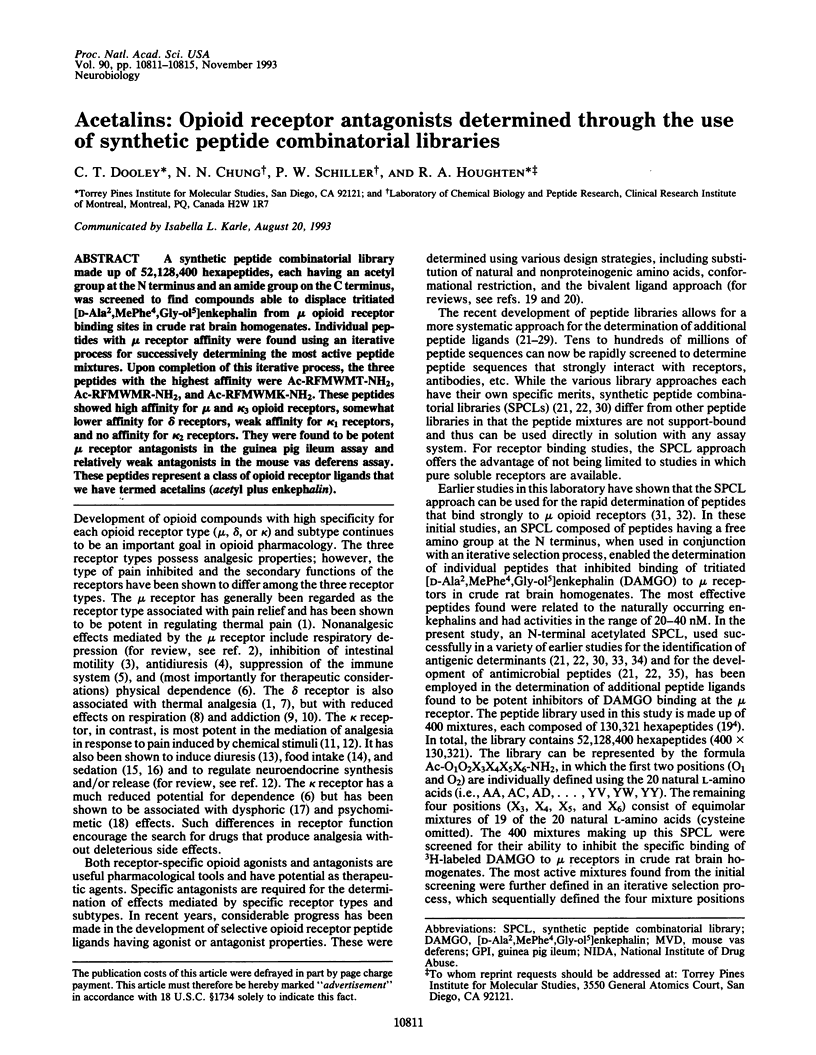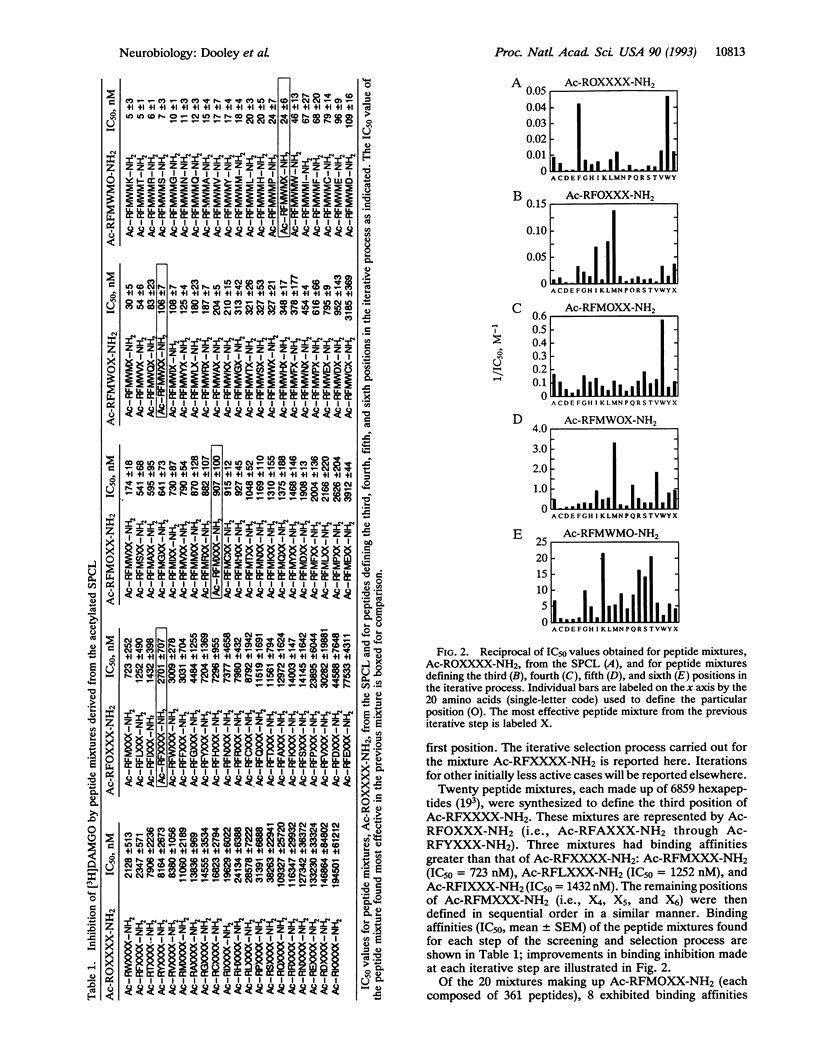Abstract
A synthetic peptide combinatorial library made up of 52,128,400 hexapeptides, each having an acetyl group at the N terminus and an amide group on the C terminus, was screened to find compounds able to displace tritiated [D-Ala2,MePhe4,Gly-ol5]enkephalin from mu opioid receptor binding sites in crude rat brain homogenates. Individual peptides with mu receptor affinity were found using an iterative process for successively determining the most active peptide mixtures. Upon completion of this iterative process, the three peptides with the highest affinity were Ac-RFMWMT-NH2, Ac-RFMWMR-NH2, and Ac-RFMWMK-NH2. These peptides showed high affinity for mu and kappa 3 opioid receptors, somewhat lower affinity for delta receptors, weak affinity for kappa 1 receptors, and no affinity for kappa 2 receptors. They were found to be potent mu receptor antagonists in the guinea pig ileum assay and relatively weak antagonists in the mouse vas deferens assay. These peptides represent a class of opioid receptor ligands that we have termed acetalins (acetyl plus enkephalin).
Full text
PDF




Selected References
These references are in PubMed. This may not be the complete list of references from this article.
- Abdelhamid E. E., Sultana M., Portoghese P. S., Takemori A. E. Selective blockage of delta opioid receptors prevents the development of morphine tolerance and dependence in mice. J Pharmacol Exp Ther. 1991 Jul 1;258(1):299–303. [PubMed] [Google Scholar]
- Burks T. F., Fox D. A., Hirning L. D., Shook J. E., Porreca F. Regulation of gastrointestinal function by multiple opioid receptors. Life Sci. 1988;43(26):2177–2181. doi: 10.1016/0024-3205(88)90410-9. [DOI] [PubMed] [Google Scholar]
- Cowan A., Zhu X. Z., Mosberg H. I., Omnaas J. R., Porreca F. Direct dependence studies in rats with agents selective for different types of opioid receptor. J Pharmacol Exp Ther. 1988 Sep;246(3):950–955. [PubMed] [Google Scholar]
- Cull M. G., Miller J. F., Schatz P. J. Screening for receptor ligands using large libraries of peptides linked to the C terminus of the lac repressor. Proc Natl Acad Sci U S A. 1992 Mar 1;89(5):1865–1869. doi: 10.1073/pnas.89.5.1865. [DOI] [PMC free article] [PubMed] [Google Scholar]
- Cwirla S. E., Peters E. A., Barrett R. W., Dower W. J. Peptides on phage: a vast library of peptides for identifying ligands. Proc Natl Acad Sci U S A. 1990 Aug;87(16):6378–6382. doi: 10.1073/pnas.87.16.6378. [DOI] [PMC free article] [PubMed] [Google Scholar]
- Devlin J. J., Panganiban L. C., Devlin P. E. Random peptide libraries: a source of specific protein binding molecules. Science. 1990 Jul 27;249(4967):404–406. doi: 10.1126/science.2143033. [DOI] [PubMed] [Google Scholar]
- DiMaio J., Nguyen T. M., Lemieux C., Schiller P. W. Synthesis and pharmacological characterization in vitro of cyclic enkephalin analogues: effect of conformational constraints on opiate receptor selectivity. J Med Chem. 1982 Dec;25(12):1432–1438. doi: 10.1021/jm00354a008. [DOI] [PubMed] [Google Scholar]
- Dooley C. T., Houghten R. A. The use of positional scanning synthetic peptide combinatorial libraries for the rapid determination of opioid receptor ligands. Life Sci. 1993;52(18):1509–1517. doi: 10.1016/0024-3205(93)90113-h. [DOI] [PubMed] [Google Scholar]
- Fodor S. P., Read J. L., Pirrung M. C., Stryer L., Lu A. T., Solas D. Light-directed, spatially addressable parallel chemical synthesis. Science. 1991 Feb 15;251(4995):767–773. doi: 10.1126/science.1990438. [DOI] [PubMed] [Google Scholar]
- Henderson G., Hughes J., Kosterlitz H. W. A new example of a morphine-sensitive neuro-effector junction: adrenergic transmission in the mouse vas deferens. Br J Pharmacol. 1972 Dec;46(4):764–766. doi: 10.1111/j.1476-5381.1972.tb06901.x. [DOI] [PMC free article] [PubMed] [Google Scholar]
- Houghten R. A., Appel J. R., Blondelle S. E., Cuervo J. H., Dooley C. T., Pinilla C. The use of synthetic peptide combinatorial libraries for the identification of bioactive peptides. Biotechniques. 1992 Sep;13(3):412–421. [PubMed] [Google Scholar]
- Houghten R. A. General method for the rapid solid-phase synthesis of large numbers of peptides: specificity of antigen-antibody interaction at the level of individual amino acids. Proc Natl Acad Sci U S A. 1985 Aug;82(15):5131–5135. doi: 10.1073/pnas.82.15.5131. [DOI] [PMC free article] [PubMed] [Google Scholar]
- Houghten R. A., Pinilla C., Blondelle S. E., Appel J. R., Dooley C. T., Cuervo J. H. Generation and use of synthetic peptide combinatorial libraries for basic research and drug discovery. Nature. 1991 Nov 7;354(6348):84–86. doi: 10.1038/354084a0. [DOI] [PubMed] [Google Scholar]
- Hruby V. J., Gehrig C. A. Recent developments in the design of receptor specific opioid peptides. Med Res Rev. 1989 Jul-Sep;9(3):343–401. doi: 10.1002/med.2610090306. [DOI] [PubMed] [Google Scholar]
- Huidobro F. Antidiuretic effect of morphine in the rat: tolerance and physical dependence. Br J Pharmacol. 1978 Oct;64(2):167–171. doi: 10.1111/j.1476-5381.1978.tb17286.x. [DOI] [PMC free article] [PubMed] [Google Scholar]
- Kumor K. M., Haertzen C. A., Johnson R. E., Kocher T., Jasinski D. Human psychopharmacology of ketocyclazocine as compared with cyclazocine, morphine and placebo. J Pharmacol Exp Ther. 1986 Sep;238(3):960–968. [PubMed] [Google Scholar]
- Lahti R. A., Mickelson M. M., McCall J. M., Von Voigtlander P. F. [3H]U-69593 a highly selective ligand for the opioid kappa receptor. Eur J Pharmacol. 1985 Feb 26;109(2):281–284. doi: 10.1016/0014-2999(85)90431-5. [DOI] [PubMed] [Google Scholar]
- Lam K. S., Salmon S. E., Hersh E. M., Hruby V. J., Kazmierski W. M., Knapp R. J. A new type of synthetic peptide library for identifying ligand-binding activity. Nature. 1991 Nov 7;354(6348):82–84. doi: 10.1038/354082a0. [DOI] [PubMed] [Google Scholar]
- Leander J. D. A kappa opioid effect: increased urination in the rat. J Pharmacol Exp Ther. 1983 Jan;224(1):89–94. [PubMed] [Google Scholar]
- Leighton G. E., Johnson M. A., Meecham K. G., Hill R. G., Hughes J. Pharmacological profile of PD 117302, a selective kappa-opioid agonist. Br J Pharmacol. 1987 Dec;92(4):915–922. doi: 10.1111/j.1476-5381.1987.tb11398.x. [DOI] [PMC free article] [PubMed] [Google Scholar]
- Maldonado R., Negus S., Koob G. F. Precipitation of morphine withdrawal syndrome in rats by administration of mu-, delta- and kappa-selective opioid antagonists. Neuropharmacology. 1992 Dec;31(12):1231–1241. doi: 10.1016/0028-3908(92)90051-p. [DOI] [PubMed] [Google Scholar]
- Mansour A., Khachaturian H., Lewis M. E., Akil H., Watson S. J. Anatomy of CNS opioid receptors. Trends Neurosci. 1988 Jul;11(7):308–314. doi: 10.1016/0166-2236(88)90093-8. [DOI] [PubMed] [Google Scholar]
- May C. N., Dashwood M. R., Whitehead C. J., Mathias C. J. Differential cardiovascular and respiratory responses to central administration of selective opioid agonists in conscious rabbits: correlation with receptor distribution. Br J Pharmacol. 1989 Nov;98(3):903–913. doi: 10.1111/j.1476-5381.1989.tb14620.x. [DOI] [PMC free article] [PubMed] [Google Scholar]
- Melchiorri P., Negri L., Falconieri-Erspamer G., Severini C., Corsi R., Soaje M., Erspamer V., Barra D. Structure-activity relationships of the delta-opioid-selective agonists, deltorphins. Eur J Pharmacol. 1991 Mar 26;195(2):201–207. doi: 10.1016/0014-2999(91)90536-y. [DOI] [PubMed] [Google Scholar]
- Morley J. E., Levine A. S. Dynorphin-(1-13) induces spontaneous feeding in rats. Life Sci. 1981 Nov 2;29(18):1901–1903. doi: 10.1016/0024-3205(81)90522-1. [DOI] [PubMed] [Google Scholar]
- PATON W. D. The action of morphine and related substances on contraction and on acetylcholine output of coaxially stimulated guinea-pig ileum. Br J Pharmacol Chemother. 1957 Mar;12(1):119–127. doi: 10.1111/j.1476-5381.1957.tb01373.x. [DOI] [PMC free article] [PubMed] [Google Scholar]
- Pfeiffer A., Brantl V., Herz A., Emrich H. M. Psychotomimesis mediated by kappa opiate receptors. Science. 1986 Aug 15;233(4765):774–776. doi: 10.1126/science.3016896. [DOI] [PubMed] [Google Scholar]
- Pinilla C., Appel J. R., Blanc P., Houghten R. A. Rapid identification of high affinity peptide ligands using positional scanning synthetic peptide combinatorial libraries. Biotechniques. 1992 Dec;13(6):901–905. [PubMed] [Google Scholar]
- Pinilla C., Appel J. R., Houghten R. A. Synthetic peptide combinatorial libraries (SPCLs): identification of the antigenic determinant of beta-endorphin recognized by monoclonal antibody 3E7. Gene. 1993 Jun 15;128(1):71–76. doi: 10.1016/0378-1119(93)90155-v. [DOI] [PubMed] [Google Scholar]
- Sagan S., Charpentier S., Delfour A., Amiche M., Nicolas P. The aspartic acid in deltorphin I and dermenkephalin promotes targeting to delta-opioid receptor independently of receptor binding. Biochem Biophys Res Commun. 1992 Sep 30;187(3):1203–1210. doi: 10.1016/0006-291x(92)90431-j. [DOI] [PubMed] [Google Scholar]
- Schiller P. W. Development of receptor-specific opioid peptide analogues. Prog Med Chem. 1991;28:301–340. doi: 10.1016/s0079-6468(08)70367-9. [DOI] [PubMed] [Google Scholar]
- Schiller P. W., Lipton A., Horrobin D. F., Bodanszky M. Unsulfated C-terminal 7-peptide of cholecystokinin: a new ligand of the opiate receptor. Biochem Biophys Res Commun. 1978 Dec 29;85(4):1332–1338. doi: 10.1016/0006-291x(78)91149-x. [DOI] [PubMed] [Google Scholar]
- Schmauss C., Yaksh T. L. In vivo studies on spinal opiate receptor systems mediating antinociception. II. Pharmacological profiles suggesting a differential association of mu, delta and kappa receptors with visceral chemical and cutaneous thermal stimuli in the rat. J Pharmacol Exp Ther. 1984 Jan;228(1):1–12. [PubMed] [Google Scholar]
- Scott J. K., Loganathan D., Easley R. B., Gong X., Goldstein I. J. A family of concanavalin A-binding peptides from a hexapeptide epitope library. Proc Natl Acad Sci U S A. 1992 Jun 15;89(12):5398–5402. doi: 10.1073/pnas.89.12.5398. [DOI] [PMC free article] [PubMed] [Google Scholar]
- Scott J. K., Smith G. P. Searching for peptide ligands with an epitope library. Science. 1990 Jul 27;249(4967):386–390. doi: 10.1126/science.1696028. [DOI] [PubMed] [Google Scholar]
- Shook J. E., Watkins W. D., Camporesi E. M. Differential roles of opioid receptors in respiration, respiratory disease, and opiate-induced respiratory depression. Am Rev Respir Dis. 1990 Oct;142(4):895–909. doi: 10.1164/ajrccm/142.4.895. [DOI] [PubMed] [Google Scholar]
- Vonvoigtlander P. F., Lahti R. A., Ludens J. H. U-50,488: a selective and structurally novel non-Mu (kappa) opioid agonist. J Pharmacol Exp Ther. 1983 Jan;224(1):7–12. [PubMed] [Google Scholar]
- Wollemann M., Benyhe S., Simon J. The kappa-opioid receptor: evidence for the different subtypes. Life Sci. 1993;52(7):599–611. doi: 10.1016/0024-3205(93)90451-8. [DOI] [PubMed] [Google Scholar]
- Yahya M. D., Watson R. R. Immunomodulation by morphine and marijuana. Life Sci. 1987 Dec 7;41(23):2503–2510. doi: 10.1016/0024-3205(87)90434-6. [DOI] [PubMed] [Google Scholar]


